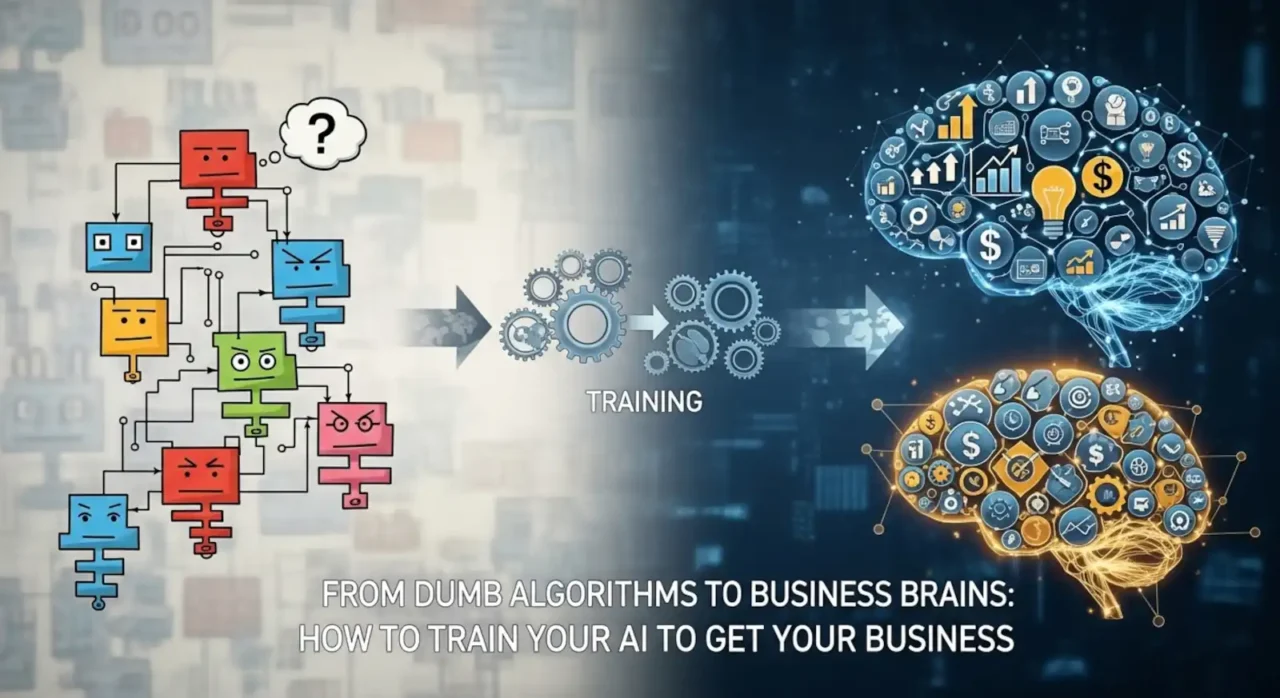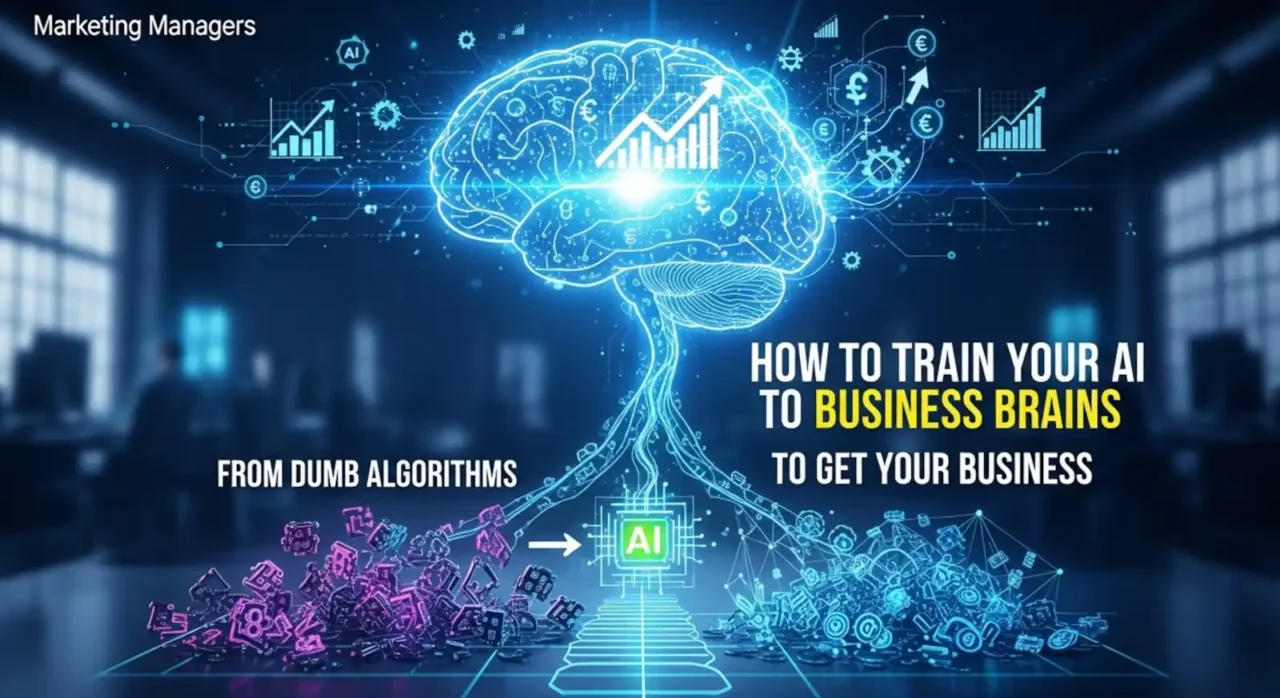From Dumb Algorithms to Business Brains: How to Train Your AI to Get Your Business
Learn From Dumb Algorithms to Business Brains: How to Train Your AI to Get Your Business.
From Dumb Algorithms to Business Brains” is like hiring an intern versus promoting a seasoned strategist. When you learn how to train your AI model, your put in performance will improve to generate more business
A dumb algorithm is the eager intern—you tell them exactly what to do, step-by-step, and they’ll follow your instructions to the letter. They’re fast, but they can’t think beyond the checklist.
A business-trained AI is the seasoned strategist—you give them the goal, the guardrails, and the budget, and they figure out the best way to get it done. They anticipate roadblocks, pivot when the data shifts, and make decisions that align with your business objectives without requiring your constant oversight.
One gets tasks done; the other gets business results.
Introduction: Is Your AI Just a Fancy Calculator?

Artificial Intelligence.
The term is ubiquitous, splashed across headlines, whispered in boardrooms, and embedded in the very fabric of our digital lives. It powers our search engines, curates our news feeds, and even attempts to predict our next Amazon purchase.
But let’s be brutally honest: is the AI currently deployed within your business truly propelling it to new heights, or is it merely performing the digital equivalent of basic arithmetic: a glorified, albeit speedy, calculator?
The mere presence of AI within an organization is no longer a badge of innovation. The true differentiator lies in its comprehension.
Does your AI grok the intricate nuances of your specific business context? Does it understand the subtle dance between your customers’ desires and your operational realities? Or is it simply regurgitating data points without genuine insight?
This post is not another breathless ode to the transformative power of AI.
Instead, it’s an invitation to embark on a critical journey, one that traces the evolution of AI in business, exposes the current landscape (warts and all), and, most importantly, illuminates the path toward building truly intelligent AI that can function as an extension of your own executive team.
We will explore how to nurture an AI that doesn’t just process data, but comprehends your business in all its glorious complexity.
I. Once Upon a Time in AI: A Blast from the Past

The Dream Begins (1950s):
The seeds of AI were sown in the mid-20th century, a period brimming with audacious dreams of creating machines that could think. The pivotal moment arrived in 1956 at Dartmouth College, where the term “Artificial Intelligence” was officially coined.
Visionaries like Alan Turing laid the theoretical groundwork, imagining machines capable of mimicking human thought processes.
Early AI systems, often referred to as GOFAI (Good Old-Fashioned Artificial Intelligence), were designed to operate based on predefined rules and logical deductions.
Think of it as teaching a child to follow a strict set of instructions – effective within a limited scope, but hardly reflective of true intelligence.
The “AI Winters”:
The initial euphoria surrounding AI proved to be short-lived. The ambitious promises of early AI often collided with the harsh realities of technological limitations.
The “AI Winters” were periods of disillusionment characterized by funding cuts and waning interest. The primary culprits?
A dearth of available data to fuel learning algorithms, insufficient computing power to process complex tasks, and the inherent rigidity of rule-based systems that struggled to adapt to real-world ambiguity.
The dream of a thinking machine remained tantalizingly out of reach.
The Machine Learning Revolution (80s-2011s):
A paradigm shift occurred with the advent of machine learning. Instead of relying solely on pre-programmed rules, AI systems began to learn from data.
Neural networks, inspired by the structure of the human brain, emerged as powerful tools for pattern recognition and prediction. This era witnessed breakthroughs that captured the public imagination.
IBM’s Deep Blue defeated chess grandmaster Garry Kasparov in 1997, demonstrating AI’s ability to “understand” and strategize within a complex, rule-governed environment.
Later, IBM’s Watson conquered the trivia challenge of Jeopardy!, showcasing AI’s capacity to process natural language and retrieve information from vast databases.
These victories were symbolic – tangible proof that AI was finally starting to “get” complex information.
This was the spark that Matrix Marketing Group needed to enter the fray of AI marketing in 2011.
2012–2015: Experimenting with Early Automation
When AI in marketing was more buzzword than business driver, Matrix Marketing Group began exploring rudimentary automation platforms.
The focus then was efficiency: automating email workflows, centralizing CRM data, and implementing rules-based lead scoring.
At this stage, AI wasn’t truly intelligent—it was closer to sophisticated “if/then” logic.
Campaigns still relied heavily on manual inputs, and data lived in silos. But these early tests revealed something important: automation could scale tasks, but it couldn’t solve process problems.
2016–2018: Data-Driven Decision Making
With marketing clouds maturing and machine learning creeping into mainstream tools, Matrix Marketing Group moved from task automation to insight automation.
Predictive analytics for lead scoring, behavioral segmentation, and early personalization began replacing static, rule-based campaigns.
Machine learning models trained on CRM and website interaction data allowed the team to anticipate customer intent, making campaign timing, channel selection, and creative relevance sharper. Still, AI was functioning as an assistant, not a strategist.
2019–2021: Integrated AI Ecosystems
The rise of API-rich ecosystems allowed Matrix Marketing Group to orchestrate tools across the marketing stack—CRM, analytics, programmatic advertising, and content management—into unified workflows.
By 2020, marketing AI could execute tasks across multiple channels based on a single trigger event. This was the groundwork for agentic orchestration: not just reacting to events but coordinating them.
This period also marked early experiments with natural language generation for SEO and content marketing, long before generative AI dominated headlines.
2022–2023: The Generative AI Inflection

The public release of advanced large language models was a tipping point.
MatrixLabX emerged during this period as the AI-native division of Matrix Marketing Group, focused entirely on developing tools that could create, optimize, and distribute marketing content at scale.
Generative AI was deployed not just for blog posts, but for:
- Social ad copy variations are generated on the fly.
- Multi-language content without traditional translation pipelines.
- Creative A/B testing at volumes impossible for human teams.
This was also the point where AI governance—bias checks, brand voice constraints, and explainability—became essential parts of the workflow.
2024: From Automation to Autonomy
By 2024, MatrixLabX had moved beyond simply generating content or triggering workflows.
AI agents began making marketing decisions: reallocating ad budgets, sequencing nurture campaigns, and adjusting creative direction based on live data, without human intervention at every step.
The operational shift was profound: marketers transitioned from operators to performance directors. Human oversight focused on strategy, compliance, and creative vision; AI handled execution and real-time optimization.
2025: Autonomous Marketing as a Business Model
Today, Matrix Marketing Group and MatrixLabX operate on the principle that autonomous marketing systems are not just tools—they’re team members.
- Agentic AI manages multi-channel campaigns end-to-end within defined goals.
- Predictive analytics anticipates market shifts before they impact KPIs.
- Personalization engines dynamically adjust brand messaging to micro-audiences in real time.
The competitive advantage no longer comes from having AI—it comes from training it to think like your business.
For MatrixLabX, the journey from 2012 to now reflects the industry’s broader evolution: from curiosity → capability → creativity → autonomy.
The Age of Generative AI (Today!):

We now find ourselves amid another AI revolution, fueled by the rise of generative AI models like ChatGPT and other Large Language Models (LLMs).
These models, trained on massive datasets, can generate human-quality text, images, and code.
Furthermore, the proliferation of AI-as-a-Service (AIaaS) platforms and low-code/no-code tools has democratized access to AI, making it easier than ever for businesses of all sizes to experiment and deploy AI solutions.
This represents a monumental leap forward, empowering organizations to leverage AI in ways that were previously unimaginable.
Closing Reflection:
Over 13 years, the path has been clear: automation speeds up the wrong process, autonomy redesigns it.
The companies that win the next decade won’t just deploy AI—they’ll train it to understand, adapt to, and drive their business forward.
Why Marketing Agencies Are Struggling With AI
1. Outdated Business Models
Agencies still bill by the hour or deliverables. AI reduces inefficiency, undercutting traditional billing.
2. Superficial AI Adoption
Many agencies just bolt on ChatGPT or Jasper without deep integration or workflow automation.
3. Lack of Technical Talent
Most agencies lack in-house data scientists or AI engineers needed for scalable, custom AI solutions.
4. Struggling to Prove ROI
They can’t measure or attribute AI’s business impact, leaving clients skeptical and ROI unclear.
5. Internal Resistance & Skill Gaps
Creative and client teams fear disruption. Leadership struggles to adapt workflows and org structures.
6. AI-Native Competitors
Tools like Jasper and MatrixLabX offer faster, cheaper, AI-powered marketing platforms that scale easily.
7. Evolving Client Expectations
CMOs expect intelligence, personalization, and speed—traditional agencies can’t keep up without AI.
What Forward-Looking Agencies Are Doing
- Shifting to performance-based pricing
- Hiring AI specialists (MLOps, prompt engineers)
- Automating internal workflows
- Offering AI-as-a-service models
- Educating clients and leading AI adoption
II. AI Today: Your Business’s Strategic Sidekick (or a Costly Headache?)
The Big Picture: It’s Not Optional Anymore!
The adoption of AI is no longer a futuristic fantasy; it’s a present-day reality. According to industry reports, over 70% of organizations are already actively utilizing AI in some form. Forward-thinking leaders recognize that AI is not merely a technological add-on but a fundamental component of their overall business strategy. The potential payoff is substantial:
Smarter Decisions: AI algorithms can sift through mountains of data, identify hidden patterns, predict future trends, and proactively flag potential risks, enabling executives to make more informed, data-driven decisions.
Productivity Power-Up: Automating repetitive, time-consuming tasks frees up human employees to focus on higher-value activities that require creativity, critical thinking, and emotional intelligence.
Customer Delight: AI-powered personalization can enhance customer experiences by delivering tailored recommendations, providing instant support through chatbots, and anticipating individual needs.
Competitive Edge: By leveraging AI to accelerate innovation, optimize processes, and anticipate market shifts, businesses can gain a significant competitive advantage.
Risk Buster: AI can be deployed to detect fraudulent transactions, identify security vulnerabilities, and monitor compliance with regulations, mitigating potential risks in real-time.
The Reality Check: Challenges & Controversies
Despite its immense potential, the path to successful AI implementation is fraught with challenges and controversies:
The Skills Gap for How to Train Your AI:
A significant impediment is the lack of skilled professionals who can effectively develop, deploy, and manage AI systems. Many employees (and even some leaders) lack the necessary AI literacy to leverage its capabilities fully.
Data Dilemmas:
The quality of data is paramount. “Garbage in, garbage out” holds – AI algorithms are only as good as the data they are trained on. Moreover, organizations must navigate the complex ethical and legal considerations surrounding data privacy and compliance.
The Bias Bug with How to Train Your AI:
AI algorithms can inadvertently perpetuate and amplify existing biases present in the training data, leading to unfair or discriminatory outcomes. Addressing bias in AI is a critical ethical imperative.
Workforce Worries:
The potential displacement of human workers due to AI automation is a legitimate concern.
However, many argue that AI will primarily augment human capabilities, creating new opportunities and transforming existing roles.
The “AI Washing” Epidemic:
Many companies engage in “AI washing,” exaggerating the extent to which they are utilizing AI. Beware of opaque, “black box” AI solutions where the underlying algorithms and decision-making processes are hidden from view.
A “glass box” approach, where transparency and explainability are prioritized, is crucial. (Solutions like Matrix Marketing Group’s MatrixLabX exemplify this approach).
Fragmented Tools (The “Gadget Tax”): Investing in a patchwork of disparate AI tools can lead to integration challenges, data silos, and ultimately, a drain on resources. A unified, cohesive AI strategy is essential.
III. The Art of Training Your AI to “Get” Your Business
The success of AI hinges not merely on the quantity of data fed into the system, but on its quality, relevance, and structure.
Simply throwing data at an AI algorithm and expecting it to magically generate insights is a recipe for disappointment.
AI Literacy for All:
Equipping employees at all levels with a basic understanding of AI, machine learning, and generative AI is essential for fostering a culture of AI adoption.
Ethical AI Training:
Training programs should emphasize the ethical considerations surrounding AI development and deployment, ensuring that AI systems are used responsibly and fairly.
Strategic Integration and How to Train Your AI:
Business leaders need to be trained on how to effectively integrate AI into the core of their business operations, rather than treating it as a peripheral tool.
The Power of Your Data:
Investing in data quality, ensuring data accuracy, and curating relevant datasets are crucial for training AI models that deliver meaningful results.
Industry-Specific Models:
Generic AI models can provide a starting point, but AI models specifically trained on your industry’s unique language, key performance indicators (KPIs), and workflows will yield far superior results. (Solutions like MatrixLabX’s industry-specific models are a testament to this approach.)
Building Your Own “Business Brain”:
The ultimate goal is to move beyond “renting” black-box AI solutions and instead build a transparent, proprietary AI system that truly understands your market, customers, and sales funnels. This “business brain” becomes a strategic asset, providing a sustainable competitive advantage.
IV. The Crystal Ball: What’s Next for Business AI?
From Dumb Algorithms to Business Brains: How to Train Your AI to Get Your Business
From Dumb Algorithms to Business Brains: How to Train Your AI to Get Your Business
Learn From Dumb Algorithms to Business Brains: How to Train Your AI to Get Your Business.
From Dumb Algorithms to Business Brains” is like hiring an intern versus promoting a seasoned strategist.
A dumb algorithm is the eager intern—you tell them exactly what to do, step-by-step, and they’ll follow your instructions to the letter. They’re fast, but they can’t think beyond the checklist.
A business-trained AI is the seasoned strategist—you give them the goal, the guardrails, and the budget, and they figure out the best way to get it done. They anticipate roadblocks, pivot when the data shifts, and make decisions that align with your business objectives without you micromanaging every move.
One gets tasks done; the other gets business results.
Introduction: Is Your AI Just a Fancy Calculator?
Artificial Intelligence. The term is ubiquitous, splashed across headlines, whispered in boardrooms, and embedded in the very fabric of our digital lives. It powers our search engines, curates our news feeds, and even attempts to predict our next Amazon purchase.
But let’s be brutally honest: is the AI currently deployed within your business truly propelling it to new heights, or is it merely performing the digital equivalent of basic arithmetic—a glorified, albeit speedy, calculator?
The mere presence of AI within an organization is no longer a badge of innovation. The true differentiator lies in its comprehension.
Does your AI grok the intricate nuances of your specific business context? Does it understand the subtle dance between your customers’ desires and your operational realities? Or is it simply regurgitating data points without genuine insight?
This post is not another breathless ode to the transformative power of AI.
Instead, it’s an invitation to embark on a critical journey – one that traces the evolution of AI in business, exposes the current landscape (warts and all), and, most importantly, illuminates the path toward building truly intelligent AI that can function as an extension of your own executive team.
We will explore how to nurture an AI that doesn’t just process data, but comprehends your business in all its glorious complexity.
I. Once Upon a Time in AI: A Blast from the Past
The Dream Begins (1950s):
The seeds of AI were sown in the mid-20th century, a period brimming with audacious dreams of creating machines that could think. The pivotal moment arrived in 1956 at Dartmouth College, where the term “Artificial Intelligence” was officially coined.
Visionaries like Alan Turing laid the theoretical groundwork, imagining machines capable of mimicking human thought processes.
Early AI systems, often referred to as GOFAI (Good Old-Fashioned Artificial Intelligence), were designed to operate based on predefined rules and logical deductions.
Think of it as teaching a child to follow a strict set of instructions – effective within a limited scope, but hardly reflective of true intelligence.
The “AI Winters”:
The initial euphoria surrounding AI proved to be short-lived. The ambitious promises of early AI often collided with the harsh realities of technological limitations.
The “AI Winters” were periods of disillusionment characterized by funding cuts and waning interest. The primary culprits?
A dearth of available data to fuel learning algorithms, insufficient computing power to process complex tasks, and the inherent rigidity of rule-based systems that struggled to adapt to real-world ambiguity.
The dream of a thinking machine remained tantalizingly out of reach.
The Machine Learning Revolution (80s-2011s):
A paradigm shift occurred with the advent of machine learning. Instead of relying solely on pre-programmed rules, AI systems began to learn from data.
Neural networks, inspired by the structure of the human brain, emerged as powerful tools for pattern recognition and prediction. This era witnessed breakthroughs that captured the public imagination.
IBM’s Deep Blue defeated chess grandmaster Garry Kasparov in 1997, demonstrating AI’s ability to “understand” and strategize within a complex, rule-governed environment.
Later, IBM’s Watson conquered the trivia challenge of Jeopardy!, showcasing AI’s capacity to process natural language and retrieve information from vast databases.
These victories were symbolic – tangible proof that AI was finally starting to “get” complex information.
This was the spark Matrix Marketing Group need to enter the fray of AI marketing in 2011.
The AI Marketing Evolution (2012s – 2025):
2012–2015: Experimenting with Early Automation
When AI in marketing was more buzzword than business driver, Matrix Marketing Group began exploring rudimentary automation platforms.
The focus then was efficiency: automating email workflows, centralizing CRM data, and implementing rules-based lead scoring.
At this stage, AI wasn’t truly intelligent—it was closer to sophisticated “if/then” logic.
Campaigns still relied heavily on manual inputs, and data lived in silos. But these early tests revealed something important: automation could scale tasks, but it couldn’t solve process problems.
2016–2018: Data-Driven Decision Making
With marketing clouds maturing and machine learning creeping into mainstream tools, Matrix Marketing Group moved from task automation to insight automation.
Predictive analytics for lead scoring, behavioral segmentation, and early personalization began replacing static, rule-based campaigns.
Machine learning models trained on CRM and website interaction data allowed the team to anticipate customer intent—making campaign timing, channel selection, and creative relevance sharper. Still, AI was functioning as an assistant, not a strategist.
2019–2021: Integrated AI Ecosystems
The rise of API-rich ecosystems allowed Matrix Marketing Group to orchestrate tools across the marketing stack—CRM, analytics, programmatic advertising, and content management—into unified workflows.
By 2020, marketing AI could execute tasks across multiple channels based on a single trigger event. This was the groundwork for agentic orchestration: not just reacting to events but coordinating them.
This period also marked early experiments with natural language generation for SEO and content marketing—long before generative AI dominated headlines.
2022–2023: The Generative AI Inflection
The public release of advanced large language models was a tipping point.
MatrixLabX emerged during this period as the AI-native division of Matrix Marketing Group, focused entirely on developing tools that could create, optimize, and distribute marketing content at scale.
Generative AI was deployed not just for blog posts, but for:
- Social ad copy variations generated on the fly.
- Multi-language content without traditional translation pipelines.
- Creative A/B testing at volumes impossible for human teams.
This was also the point where AI governance—bias checks, brand voice constraints, and explainability—became essential parts of the workflow.
2024: From Automation to Autonomy
By 2024, MatrixLabX had moved beyond simply generating content or triggering workflows.
AI agents began making marketing decisions: reallocating ad budgets, sequencing nurture campaigns, and adjusting creative direction based on live data—without human intervention at every step.
The operational shift was profound: marketers transitioned from operators to performance directors. Human oversight focused on strategy, compliance, and creative vision; AI handled execution and real-time optimization.
2025: Autonomous Marketing as a Business Model
Today, Matrix Marketing Group and MatrixLabX operate on the principle that autonomous marketing systems are not just tools—they’re team members.
- Agentic AI manages multi-channel campaigns end-to-end within defined goals.
- Predictive analytics anticipates market shifts before they impact KPIs.
- Personalization engines dynamically adjust brand messaging to micro-audiences in real time.
The competitive advantage no longer comes from having AI—it comes from training it to think like your business.
For MatrixLabX, the journey from 2012 to now reflects the industry’s broader evolution: from curiosity → capability → creativity → autonomy.
The Age of Generative AI (Today!):
We now find ourselves amid another AI revolution, fueled by the rise of generative AI models like ChatGPT and other Large Language Models (LLMs).
These models, trained on massive datasets, can generate human-quality text, images, and code.
Furthermore, the proliferation of AI-as-a-Service (AIaaS) platforms and low-code/no-code tools has democratized access to AI, making it easier than ever for businesses of all sizes to experiment and deploy AI solutions.
This represents a monumental leap forward, empowering organizations to leverage AI in ways that were previously unimaginable.
Closing Reflection:
Over 13 years, the path has been clear: automation speeds up the wrong process, autonomy redesigns it.
The companies that win the next decade won’t just deploy AI—they’ll train it to understand, adapt to, and drive their business forward.
II. AI Today: Your Business’s Strategic Sidekick (or a Costly Headache?)
The Big Picture: It’s Not Optional Anymore!
The adoption of AI is no longer a futuristic fantasy; it’s a present-day reality. According to industry reports, over 70% of organizations are already actively utilizing AI in some form. Forward-thinking leaders recognize that AI is not merely a technological add-on, but a fundamental component of their overall business strategy. The potential payoff is substantial:
Smarter Decisions: AI algorithms can sift through mountains of data, identify hidden patterns, predict future trends, and proactively flag potential risks – enabling executives to make more informed, data-driven decisions.
Productivity Power-Up: Automating repetitive, time-consuming tasks frees up human employees to focus on higher-value activities that require creativity, critical thinking, and emotional intelligence.
Customer Delight: AI-powered personalization can enhance customer experiences by delivering tailored recommendations, providing instant support through chatbots, and anticipating individual needs.
Competitive Edge: By leveraging AI to accelerate innovation, optimize processes, and anticipate market shifts, businesses can gain a significant competitive advantage.
Risk Buster: AI can be deployed to detect fraudulent transactions, identify security vulnerabilities, and monitor compliance with regulations, mitigating potential risks in real-time.
The Reality Check: Challenges & Controversies
Despite its immense potential, the path to successful AI implementation is fraught with challenges and controversies:
The Skills Gap:
A significant impediment is the lack of skilled professionals who can effectively develop, deploy, and manage AI systems. Many employees (and even some leaders) lack the necessary AI literacy to fully leverage its capabilities.
Data Dilemmas:
The quality of data is paramount. “Garbage in, garbage out” holds true – AI algorithms are only as good as the data they are trained on. Moreover, organizations must navigate the complex ethical and legal considerations surrounding data privacy and compliance.
The Bias Bug:
AI algorithms can inadvertently perpetuate and amplify existing biases present in the training data, leading to unfair or discriminatory outcomes. Addressing bias in AI is a critical ethical imperative.
Workforce Worries:
The potential displacement of human workers due to AI automation is a legitimate concern.
However, many argue that AI will primarily augment human capabilities, creating new opportunities and transforming existing roles.
The “AI Washing” Epidemic:
Many companies engage in “AI washing,” exaggerating the extent to which they are utilizing AI. Beware of opaque, “black box” AI solutions where the underlying algorithms and decision-making processes are hidden from view.
A “glass box” approach, where transparency and explainability are prioritized, is crucial. (Solutions like Matrix Marketing Group’s MatrixLabX exemplify this approach).
Fragmented Tools (The “Gadget Tax”): Investing in a patchwork of disparate AI tools can lead to integration challenges, data silos, and ultimately, a drain on resources. A unified, cohesive AI strategy is essential.
III. The Art of Training Your AI to “Get” Your Business
The success of AI hinges not merely on the quantity of data fed into the system, but on its quality, relevance, and structure.
Simply throwing data at an AI algorithm and expecting it to magically generate insights is a recipe for disappointment.
AI Literacy for All:
Equipping employees at all levels with a basic understanding of AI, machine learning, and generative AI is essential for fostering a culture of AI adoption.
Ethical AI Training:
Training programs should emphasize the ethical considerations surrounding AI development and deployment, ensuring that AI systems are used responsibly and fairly.
Strategic Integration:
Business leaders need to be trained on how to effectively integrate AI into the core of their business operations, rather than treating it as a peripheral tool.
Tailoring AI for Your World:
The Power of Your Data:
Investing in data quality, ensuring data accuracy, and curating relevant datasets are crucial for training AI models that deliver meaningful results.
Industry-Specific Models:
Generic AI models can provide a starting point, but AI models specifically trained on your industry’s unique language, key performance indicators (KPIs), and workflows will yield far superior results. (Solutions like MatrixLabX’s industry-specific models are a testament to this approach).
Building Your Own “Business Brain”:
The ultimate goal is to move beyond “renting” black-box AI solutions and instead build a transparent, proprietary AI system that truly understands your market, customers, and sales funnels. This “business brain” becomes a strategic asset, providing a sustainable competitive advantage.
IV. The Crystal Ball: What’s Next for Business AI?
- The Dawn of Agentic AI:
- The next frontier in AI is the development of agentic AI – systems that can set their own goals, plan actions, reason about the world, and collaborate autonomously.
- Imagine AI agents that can manage complex workflows, make decisions without constant human intervention, and proactively identify opportunities for improvement.
- Business AI will evolve from reactive assistants to proactive strategists—anticipating market shifts, autonomously executing campaigns, and learning your business DNA to drive growth with precision, speed, and ethical guardrails.
Conclusion: Future-Proofing Your Enterprise, One AI Brain at a Time
From rudimentary programs to sophisticated, understanding partners, the journey of AI is fundamentally reshaping the business landscape.
The ability to effectively train and integrate AI to truly understand your business is no longer merely a competitive advantage; it is rapidly becoming a strategic imperative for survival.
The question is no longer whether to embrace AI, but how to cultivate AI that thinks for itself (and for you). What is your first step in building your business’s AI brain? The future of your enterprise may very well depend on it.
Conclusion: Future-Proofing Your Enterprise, One AI Brain at a Time
From rudimentary programs to sophisticated, understanding partners, the journey of AI is fundamentally reshaping the business landscape.
The ability to effectively train and integrate AI to truly understand your business is no longer merely a competitive advantage; it is rapidly becoming a strategic imperative for survival.
The question is no longer whether to embrace AI, but how to cultivate AI that thinks for itself (and for you). What is your first step in building your business’s AI brain? The future of your enterprise may very well depend on it.

